
Zaxxon is a scrolling shooter developed and released by Sega as an arcade video game in 1982. The player pilots a ship through heavily defended space fortresses. Japanese electronics company Ikegami Tsushinki was also involved in the game's development.
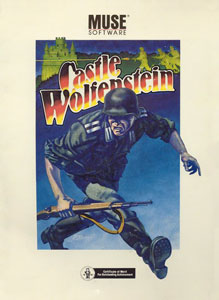
Castle Wolfenstein is a 1981 action-adventure game developed by Silas Warner for the Apple II and published by Muse Software in 1981. It is one of the earliest games based on stealth mechanics. A port to Atari 8-bit computers was released in 1982, followed by Commodore 64 (1983) and MS-DOS (1984). The player takes the role of an Allied prisoner of war during World War II who held captive in the fictional Castle Wolfenstein. After escaping from a cell, the player's objective is to find the Nazis' secret war plans and escape from the castle. Nazi soldiers can be dealt with via impersonation, sneaking, or killing.

Berzerk is a multidirectional shooter designed by Alan McNeil and released for arcades in 1980 by Stern Electronics of Chicago. Following Taito's Stratovox, it is one of the first arcade video games with speech synthesis. Berzerk places the player in a series of top-down, maze-like rooms containing armed robots. Home ports were published for the Atari 2600, Atari 5200, and Vectrex.

Drol is a video game published by Broderbund in 1983. It was written for the Apple II by Benny Aik Beng Ngo, then ported to the Commodore 64 and Atari 8-bit computers. Versions were released for the SG-1000 in 1985 and Amiga in 1991.
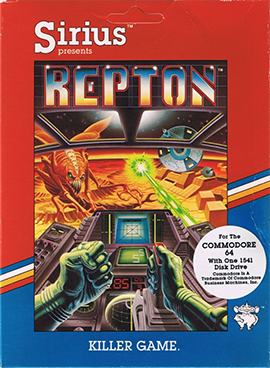
Repton is a Defender-inspired scrolling shooter written by Dan Thompson and Andy Kaluzniacki for the Apple II and published by Sirius Software in 1983. It was ported to the Atari 8-bit computers, and Commodore 64.
Cathryn Mataga is a game programmer and founder of independent video game company Junglevision. Under the name William, she wrote Atari 8-bit computer games for Synapse Software in the early to mid 1980s, including Shamus, a flip-screen shooter.
Synapse Software Corporation was an American software developer and publisher founded in 1981 by Ihor Wolosenko and Ken Grant. Synapse published application software and developer tools and was primarily known for video games. It initially focused on the Atari 8-bit computers, then later developed for the Commodore 64 and other systems. Synapse was purchased by Broderbund in late 1984 and the Synapse label retired in 1985.

Crossfire is a multidirectional shooter created by Jay Sullivan for the Apple II and published by On-Line Systems in 1981. Using keyboard-based twin-stick shooter controls, the player maneuvers a ship in a grid-like maze. Versions with joystick-control use the stick for movement and switch to firing mode when the button is held down.

Blue Max is a scrolling shooter written by Bob Polin for Atari 8-bit computers and published by Synapse Software in 1983. It was released for the Commodore 64 the same year. U.S. Gold published the Commodore 64 version in the UK in 1984 and ported the game to the ZX Spectrum. In 1987, Atari Corporation published Blue Max as a cartridge styled for the then-new Atari XEGS.

The Mask of the Sun is a graphical interactive fiction game for the Apple II developed by Ultrasoft and published in 1982 in North America by Broderbund and in Europe by Ariolasoft. Versions for the Atari 8-bit computers and Commodore 64 were released in 1984.

Astro Chase is a multidirectional shooter written by Fernando Herrera for Atari 8-bit computers. It was published by First Star Software in 1982 as the company's first game. Parker Brothers licensed it, releasing cartridge versions for the Atari 8-bit family and Atari 5200 console in 1983 and a Commodore 64 version in 1984. Exidy licensed it for arcade use with its Max-A-Flex cabinet.

Gateway to Apshai is an action-adventure game for the Commodore 64, ColecoVision and Atari 8-bit computers. It was developed by The Connelley Group and published by Epyx in 1983 as a prequel to Temple of Apshai. It is a more action-oriented version of Temple of Apshai, with smoother and faster graphics, streamlined controls, fewer role-playing video game elements, and fewer room descriptions.

Fort Apocalypse is a multidirectional scrolling shooter for Atari 8-bit computers created by Steve Hales and published by Synapse Software in 1982. Joe Vierra ported it to the Commodore 64 the same year. The player navigates an underground prison in a helicopter, destroying or avoiding enemies and rescuing prisoners. A contemporary of Choplifter, it has similarities to that game as well as the arcade games Scramble and Super Cobra.
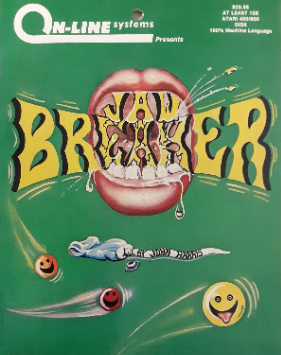
Jawbreaker is a Pac-Man clone programmed by John Harris for Atari 8-bit computers and published by On-Line Systems. Released in 1981 before an official version of Pac-Man was available, it was widely lauded by reviewers and became a major seller. The story of its creation and Harris's Atari 8-bit implementation of Frogger form a portion of Steven Levy's 1984 book, Hackers: Heroes of the Computer Revolution.

Dandy is a dungeon crawl maze video game for Atari 8-bit computers published by the Atari Program Exchange in 1983. It is one of the first video games with four-player, simultaneous cooperative play. Players equipped with bows and unlimited arrows fight through a maze containing monsters, monster spawners, keys, locked doors, food, and bombs in search of the exit leading to the next level. If a player dies, they can be revived by finding and shooting a heart. The game includes an editor for making new dungeons.
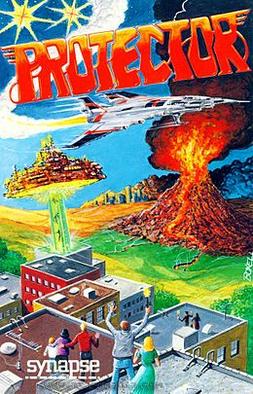
Protector is a 1981 scrolling shooter for Atari 8-bit computers programmed by Mike Potter and distributed first by Crystalware and then Synapse Software. A VIC-20 port was published by HesWare in 1983.
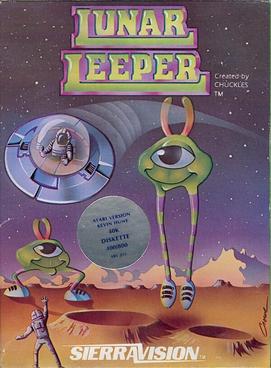
Lunar Leeper, also released as Lunar Leepers, is a horizontally scrolling shooter written by Chuck Bueche and published under Sierra On-Line's SierraVision label in 1982. It was released for the Apple II, Atari 8-bit computers, Commodore 64, and VIC-20. The Apple II version was copy-protected using Sierra's Spiradisc system.

Shamus: Case II is a 1983 video game for Atari 8-bit computers written by Cathryn Mataga and published by Synapse Software. Mataga also wrote the original Shamus and the scrolling shooter Zeppelin. A port to the Commodore 64 by Joe Vierra was released in 1984. Although ostensibly a sequel to Shamus, the gameplay is very different, combining aspects of platform games, maze games, and even Breakout. Case II was as well received as the original.

Bandits is a 1982 fixed shooter written by Tony and Benny Ngo for the Apple II and published by Sirius Software. The game is a clone of Taito's 1980 Stratovox arcade video game where the goal is to prevent aliens from stealing objects. Bandits was ported to the Atari 8-bit computers, Commodore 64, and VIC-20.

Dodge Racer is a maze video game programmed by Rob Re for Atari 8-bit computers and published by Synapse Software in 1981. It is a clone of the 1979 arcade video game Head On, where the player drives around a rectangular track, divided into lanes, collecting dots and avoiding collisions. Dodge Racer was the second release from Synapse and the company's first game.



















